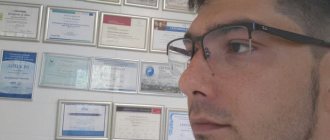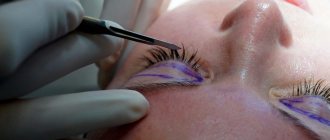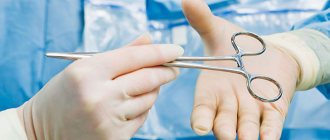Plastic surgeon Mikhail Krylov
The facelift is probably the most famous plastic surgery procedure to come out over the years. Facelift has undergone significant improvements and currently remains one of the most predictable and safe corrections that brings back youth. Although some celebrities have distorted faces after botched plastic surgery, a proper facelift performed by an experienced plastic surgeon will provide facial rejuvenation that is natural and does not show easily detectable signs of surgery. We talked about facelift and aesthetic medicine with plastic surgeon Mikhail Sergeevich Krylov.
Corr.: Who are the best candidates for plastic surgery?
Mikhail Krylov : The ideal candidate for plastic surgery is a person who wants to change their appearance and is motivated internally (i.e. not for an external reason such as getting a promotion, saving a marriage, etc.) These people are motivated because they believe that changing their appearance will help improve their self-esteem. Medically speaking, an excellent candidate would be someone who is in generally good health and does not have diabetes or other serious medical conditions. People with mental disorders are also not allowed to undergo plastic surgery.
Corr.: What do you recommend as the best strategy for preserving youth and combating age? And is it too late to try to “remove” 5-10 years from your face with the help of a facelift and other cosmetic procedures?
Mikhail Krylov : For people who would like to prevent the aging process, there is a growing range of gentle procedures and new technologies that can quickly correct the aging process. There has been an explosion of change in the field with the introduction of “injectables” such as Botox, Restylane and lipofilling, as well as new laser skin treatments that use non-ablative lasers to stimulate cell regeneration. Additionally, skin care products prescribed by an esthetician are a great way to rejuvenate the skin by removing dead skin cells, as well as evening out skin tone, removing discoloration, and more.
My priority is caring for my patients and earning their trust.
There are several cosmetic and surgical procedures that can be performed before a classic deep facelift. For example, an eyelid lift can serve as a rejuvenating plastic surgery. It is important to ask your plastic surgeon what the right approach is for you because the doctor will take into account your age, bone structure, skin tone, overall health and what results you want to see. And it's never too late! With the latest technologies in skin resurfacing, age correction, and less invasive methods of plastic surgery, we can say with confidence that it is never too late to become younger.
Corr.: What do you think about facelifts such as endotin? Is there potential?
Mikhail Krylov : These new, "fast" facelifts are basically performed using a technique where a thread with attached barbs is attached under the skin, grabs the tissue from the inside, and then the skin is stretched by these threads and fixed in a higher position. This type of facelift is less expensive and takes less time, but the results are typically not as optimal as with a traditional facelift. My honest opinion about these types of procedures is that you get out what you put into them... Therefore, before making a final decision, the patient needs to take into account what type of results they want and for how long.
Corr.: Let's talk about Botox, Restalane and other injectable drugs. Can you prolong the youthfulness of your skin until the moment you “need” a facelift? Will These Alternatives Help Against Wrinkles?
Mikhail Krylov: The popularity of using Botox injections, as well as injectable drugs such as Restylane, is growing by leaps and bounds. The trend in plastic surgery has moved away from traditional facelifts, where the skin is pulled taut without “filling in” areas where youthful fat has been lost. If you are observant, you will see that a small child or young adult's face reflects youth with moisturized skin, a slightly full face, and plump, wrinkle-free lips. To restore youth, plastic surgeons have realized how important it is not just to tighten the skin, but also to fill in hollows, lines, and areas of the face that have lost volume. Drugs such as Restylane, giving the face a fuller, more youthful appearance. Restylane and other fillers are also used to plump up thin lips that are naturally thin or have lost volume with age. These injectables help create a more youthful appearance. Botox injections work differently... They are simply injected into areas where muscles contract, causing wrinkles and lines. It sometimes takes up to ten days for a Botox injection to take effect. When it begins to work, the muscles are paralyzed, preventing the movement that caused deep furrows, wrinkles around the mouth, and also in the eye area. Once this happens, wrinkles become much less noticeable. Cosmetologists and plastic surgeons can use injectable medications to delay the time when a facelift is needed, in some cases for 5 to 7 years.
Corr.: How much of your business is aimed at helping people who have previously had unsuccessful surgery?
Mikhail Krylov: Let's just say that in my practice I sometimes encounter patients who have undergone a primary operation with which they are not happy. There really is a need to regain trust in a new surgeon after a patient has had negative results with another plastic surgeon. When patients come to me for help correcting what they feel is less than ideal, they trust my surgical and aesthetic judgment as they seek a solution to their problem.
People with mental disorders are not allowed to undergo plastic surgery
Corr.: What awaits us in the field of plastic surgery? Are there any new treatments or products worth checking out?
Mikhail Krylov: New non-invasive laser techniques will be developed in the field of skin restoration and rejuvenation, but for many these procedures are still too expensive. In the future, it is necessary to improve these technologies and also make them more affordable. In addition, various surgical techniques are constantly being improved, allowing patients to reduce recovery time after surgery.
Corr.: Nowadays there are many plastic surgeons who keep patients informed. How important is this aspect to them?
Mikhail Krylov : Patient awareness benefits all parties involved. If a client is armed with the knowledge of what questions to ask and what the answers should be, they are better equipped to choose the right plastic surgeon. My priority is to care for my patients and earn the trust of them, as well as my colleagues in the medical community. So, yes, disseminating accurate information about surgeries and making it available to patients is a very important part of the process.
Krylov Viktor Solomonovich (03/18/1925–12/02/2021)
News
December 3, 2021
On December 2, 2022, after a long illness, the world-famous legendary Soviet and Russian surgeon, scientist, doctor of medical sciences, professor passed away.
KRYLOV VIKTOR SOLOMONOVICH
Viktor Solomonovich was born on March 18, 1925. in Perm, in a family of doctors.
Viktor Solomonovich graduated from the Molotov Medical Institute in 1945 (now Perm State Medical University (PSMU) named after Academician E.A. Wagner) and there he completed postgraduate studies in topographic anatomy and operative surgery in 1945-1948. The topic of the candidate's dissertation is “Innervation of the muscles of the human thigh and lower leg” (Perm, 1947). In 1948-58 he worked as a surgeon at the Molotov Regional Hospital (now the Perm Clinical Cardiological Dispensary).
In 1959-1973 he headed the Department of Vascular Surgery of the Department of Faculty Surgery of the First Moscow Medical Institute. THEM. Sechenov. Defended his doctoral dissertation on the topic “Bypass surgery and prosthetics of blood vessels” (Moscow, 1960). In 1969-86 he worked as a senior researcher and since 1975 headed the microsurgery department of the All-Union Scientific Center of Surgery of the USSR Academy of Medical Sciences. In 1986-92, he headed the Department of Microsurgery at the Central Institute for Advanced Medical Studies in Moscow. For more than 25 years he served as scientific editor of the Abstract Medical Journal (section “Surgery”). Since 1993, he taught the course “vascular microsurgery” at the International Microsurgery Courses in Moscow.
Founder of the scientific direction “reconstructive microsurgery” in Russia as applied to various surgical specialties (plastic surgery, neurosurgery, trauma surgery, infertility treatment, pediatric microsurgery, vascular surgery, phlebology, lymphology). In 1964, together with academician B.V. Petrovsky was the first to perform a kidney transplant in the USSR. One of the authors of the kidney transplantation technique. He organized the first departments for kidney transplantation in a number of cities of the USSR (Minsk, Tashkent, Saratov, Kemerovo, Khabarovsk, Irkutsk, Yerevan).
In 1973 he founded the direction of “reconstructive hand microsurgery”. Organized a finger replantation service in Moscow. For the first time in the USSR, he performed bypass surgery for occlusion of the femoral artery. He developed a microsurgical technique for operations on peripheral nerves and small vessels. He worked on problems of organ and tissue transplantation; carried out transplantation of skin-subcutaneous flaps using microsurgical techniques for burns. Together with his colleagues, he performed (1984) the first operations to transplant four toes onto the hand. Has more than 300 scientific publications.
Since 2002, consultant on phlebology and lymphology at the National Medical Research Center for Cardiology of the Ministry of Health of the Russian Federation in Moscow.
Awarded the USSR State Prize in 1982 (team of authors) “for the development of emergency microsurgical operations for traumatic amputations of the fingers and hand.”
Honorary Member of St. Luke's Hospital (St. Louis, USA), honorary doctor of the Friedrich Schiller University of Jena (Jena, Germany), full member of the Societies of Surgeons of Lithuania, Cuba, the International Society of Surgeons and the International Union of Angiologists.
Viktor Solomonovich trained a galaxy of prominent world-famous scientists and surgeons in various areas of reconstructive microsurgery, an active life and scientific position, and until his last days he actively worked within the walls of the Cardiocenter. Relatives and friends, students, colleagues, friends and patients mourn this irreparable loss, and the bright memory of this wonderful man will forever remain in the hearts of those who worked with him, knew him, loved and respected him. We remember and mourn.
Since 1994, he worked in Israel as a consultant on microsurgery at the Medical University and as a professor at Tel Aviv University.
Since 1998, he worked in the USA, first as a professor at the University of Illinois at Urbana-Champaign, then directed the Krylov Clinic for Venous Care at the Provena Covenant Medical Center hospital (Urbana, Illinois).
Viktor Solomonovich Krylov was born on March 18, 1925 in Perm into a medical family. Mother - Krylova Maria Borisovna - a well-known obstetrician-gynecologist in Russia at that time, father - Krylov Solomon Isaevich - maxillofacial surgeon, director of the Institute of Dentistry, Odontology and Orthopedics in Perm.
It is quite natural that the son followed in the footsteps of his parents, and in 1945 he successfully graduated from the Perm Medical Institute, where he continued his postgraduate studies at the Department of Topographic Anatomy and Operative Surgery, and then, after successfully defending his Ph.D. thesis in 1948 (“Innervation muscles of the human thigh and lower leg"), became an assistant in the same department. Don't be V.S. Krylov as an assistant at the department, perhaps he would not have met the blue-eyed student Lenochka, who soon became his companion, and for life.
The desire to go beyond anatomy and move into the clinic, on the one hand, and accusations of “nepotism” (“the whole family are doctors and work at the same Institute”), on the other, led V.S. Krylov to the decision to leave Perm.
Subsequently, he worked as a surgeon in a large medical unit of a plant in the Moscow region, then moved to Sverdlovsk (now Yekaterinburg) and worked in the regional hospital No. 1 of Sverdlovsk as a surgeon.
By 1951, Viktor Solomonovich went to work at the Research Institute of Reconstructive Surgery, Traumatology and Orthopedics of Sverdlovsk (VOSKHITO Institute), where in 5 years he became a senior researcher, head of the experimental department of the institute. Here, the young doctor performed the first successful prosthetics of the femoral artery in the USSR in case of injury (gunshot wound) and gained experience in vascular prosthetics using synthetic tissues. With the name V.S. Krylov is associated with the development of angiology and vascular surgery in our country. Viktor Solomonovich was appointed the first head of the new department of vascular surgery, headed by Professor B.V. Petrovsky Hospital Surgical Clinic of the 1st MOLMI named after. Sechenov in Moscow.
In this department, the first successful reconstructive operations on the aorta and its branches were performed, as well as reconstructive operations on the arteries of the upper and lower extremities, including reconstructive operations for arteriovenous aneurysms (consequences of injuries during the Great Patriotic War).
In 1962 V.S. Krylov successfully defended his doctoral dissertation on the topic “Permanent bypass and prosthetics in vascular surgery.”
In fact, the first experience of reconstructive operations on the aorta and its branches became the basis for the spread and development of vascular surgery in our country.
V.S. Krylov is a participant in the first kidney transplantation in the USSR, performed by B.V. Petrovsky in 1965, author of 300 published works, including 5 monographs and many speeches at all-Union and world conferences.
The period of life of Professor V.S. Krylov from 1966 to 1973 was always under the shadow of secrecy. It is only known that during these years V.S. Krylov was the head of the computer science department of the same clinic, already academician B.V. Petrovsky (elected in 1966). Since 1973 V.S. Krylov headed the newest direction at that time and the most relevant to this day - vascular microsurgery. “Link” by Professor V.S. Krylov’s transfer to the scientific and organizational department did not break his searching spirit - the spirit of a scientist and doctor. Beginning in the 70s, Viktor Solomonovich informed Academician B.V. Petrovsky about news in this area. Microsurgery was entrusted to a person who was able to do much to achieve a new goal. This happened with surgery of the peripheral arteries and aortoiliac zone, and this happened with brachycephalic vessels and kidney transplantation.
In a short period of time, the microsurgery group has grown into a department consisting of an emergency department on the basis of City Clinical Hospital No. 51 of Moscow and a planned department in the Center. Emergency operations for amputations of fingers, transplantation of skin flaps with feeding vessels and nerves, bone fragments on muscle vessels, musculocutaneous flaps, complex transplantations of toes onto a fingerless hand, suture of lymphatic vessels, fallopian tubes and vas deferens - this is an incomplete list of areas where V.S. worked Krylov. Of course, Viktor Solomonovich’s school also grew: about 30 candidates and 15 doctors of science! The editors of many international and Soviet medical publications considered it an honor to have a professor on the editorial board, and surgical congresses and societies included Viktor Solomonovich on the organizing committees.
In 1985 V.S. Krylov organized and headed the first and only department of microsurgery in the USSR. It was opened at the Central Order of Lenin Institute for Advanced Training of Doctors. Doctors of many surgical specialties were trained on the basis of this department. This marked the beginning of the creation of microsurgery departments and centers in many large cities of the USSR. With the beginning of perestroika and the retirement of V.S. Krylov left the country. For several years he worked as a professor of microsurgery in Israel, then moved to the USA, where for more than 5 years he headed a venous surgical clinic, performed reconstructive operations with microsurgery for valvular venous insufficiency, while simultaneously developing aspects of venous valvuloplasty for chronic venous insufficiency. And, by the way, the professor taught lessons in microvascular surgery and conducted systematic courses in practical microsurgery for vascular surgery residents (University of Tennessee, Knoxville, USA). Many American vascular surgeons are still grateful to Viktor Solomonovich for the lessons in microvascular technology.
In recent years, after returning “to normal” to Russia, Viktor Solomonovich has been actively working on the problem of creating a prosthetic venous valve for the treatment of chronic venous insufficiency of the lower extremities. There is hope for a successful solution to the problem.
Viktor Solomonovich is a wonderful family man, he has three daughters and many grandchildren and great-grandchildren.
The staff of the Department of Cardiovascular Surgery of the Russian Cardiology Research and Production Complex, as well as the editorial board of the journal Surgery, wish him happiness and creative longevity.








